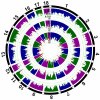Enhancing Genomic Prediction Accuracy of Reproduction Traits in Rongchang Pigs Through Machine Learning
- PMID: 40003007
- PMCID: PMC11852217
- DOI: 10.3390/ani15040525
Enhancing Genomic Prediction Accuracy of Reproduction Traits in Rongchang Pigs Through Machine Learning
Abstract
The increasing volume of genome sequencing data presents challenges for traditional genome-wide prediction methods in handling large datasets. Machine learning (ML) techniques, which can process high-dimensional data, offer promising solutions. This study aimed to find a genome-wide prediction method for local pig breeds, using 10 datasets with varying SNP densities derived from imputed sequencing data of 515 Rongchang pigs and the Pig QTL database. Three reproduction traits-litter weight, total number of piglets born, and number of piglets born alive-were predicted using six traditional methods and five ML methods, including kernel ridge regression, random forest, Gradient Boosting Decision Tree (GBDT), Light Gradient Boosting Machine, and Adaboost. The methods' efficacy was evaluated using fivefold cross-validation and independent tests. The predictive performance of both traditional and ML methods initially increased with SNP density, peaking at 800-900 k SNPs. ML methods outperformed traditional ones, showing improvements of 0.4-4.1%. The integration of GWAS and the Pig QTL database enhanced ML robustness. ML models exhibited superior generalizability, with high correlation coefficients (0.935-0.998) between cross-validation and independent test results. GBDT and random forest showed high computational efficiency, making them promising methods for genomic prediction in livestock breeding.
Keywords: Rongchang pigs; genomic prediction; machine learning; prediction accuracy.
Conflict of interest statement
The authors declare that they have no competing interests.
Figures








Similar articles
-
Using machine learning to improve the accuracy of genomic prediction of reproduction traits in pigs.J Anim Sci Biotechnol. 2022 May 17;13(1):60. doi: 10.1186/s40104-022-00708-0. J Anim Sci Biotechnol. 2022. PMID: 35578371 Free PMC article.
-
An investigation of machine learning methods applied to genomic prediction in yellow-feathered broilers.Poult Sci. 2025 Jan;104(1):104489. doi: 10.1016/j.psj.2024.104489. Epub 2024 Nov 1. Poult Sci. 2025. PMID: 39571199 Free PMC article.
-
Using machine learning to realize genetic site screening and genomic prediction of productive traits in pigs.FASEB J. 2023 Jun;37(6):e22961. doi: 10.1096/fj.202300245R. FASEB J. 2023. PMID: 37178007
-
Genomic prediction of pig growth traits based on machine learning.Yi Chuan. 2023 Oct 20;45(10):922-932. doi: 10.16288/j.yczz.23-120. Yi Chuan. 2023. PMID: 37872114
-
Survey of SNPs Associated with Total Number Born and Total Number Born Alive in Pig.Genes (Basel). 2020 Apr 30;11(5):491. doi: 10.3390/genes11050491. Genes (Basel). 2020. PMID: 32365801 Free PMC article. Review.
References
-
- Nishio M., Arakawa A., Inoue K., Ichinoseki K., Kobayashi E., Okamura T., Fukuzawa Y., Ogawa S., Taniguchi M., Oe M., et al. Evaluating the performance of genomic prediction accounting for effects of single nucleotide polymorphism markers in reproductive traits of Japanese Black cattle. Anim. Sci. J. 2023;94:e13850. doi: 10.1111/asj.13850. - DOI - PubMed
Grants and funding
LinkOut - more resources
Full Text Sources

